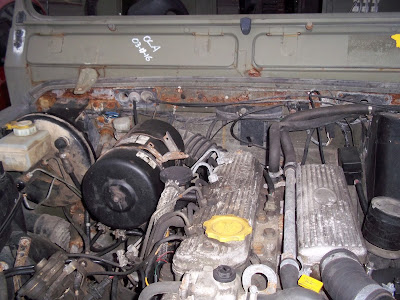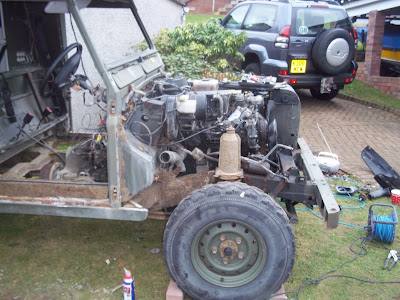December 2016
Having bought the Land Rover as project vehicle with a view to rebuilding it as a reliable, capable and comfortable expedition vehicle my plan was to strip it back to a bare chassis and really start from scratch there as mechanical reliability and performance is for me more a priority than the aesthetics of the vehicle. So saying that I want a vehicle that is aesthetically pleasing and comfortable as well, but reliability and capability are my main concerns
Being home for three weeks over the Christmas period allowed me time to see what I had bought and to start stripping it back to a bare chassis.
As I plan to document this project as it progresses probably the first thing to do is to give the Land Rover a name so without a great lot of thought the Land Rover is now referred to as "Wolfie". This is basically derived from the Wolf variant Land Rover developed for the MOD and not as my son thinks named after his cat which is called Wolfgang.
Overall "Wolfie" looked to be in pretty decent shape. Despite the wording of the advert which when I bought it advised that the rear cross member needed replaced, the chassis appeared to be in pretty good condition.
The bodywork was as envisaged, the ambulance body itself was in pretty good condition, with a broken hinge on the rear door and a couple of scrapes along the sides being the only real issues. The Land Rover itself was a different issue as the front wings and bonnet all showed signs of wear and tear and with the usual Land Rover dents caused by people standing on them. At this stage I think my plan is to repair the wings and potentially replace the bonnet, but I will see as the bodywork stage is far off in the future.
The cab doors were in a poor state. The drivers door had been repaired with an unsightly alloy plate pop riveted on to secure the upper and lower door halves - a really bodged job and not one that I could really envisage the military condoning. The passenger door was a bit better, although the bottom of the door was showing it's age a brand new upper window section had been fitted - really at odds with the bodged repair to the drivers doors.
The bulkhead was as expected pretty rusty - repairable, but rusty. Having bought Wolfie knowing this I had already sourced a replacement from a 2015 Defender. This newer bulkhead does not have the opening vent panels, but as the Pulse has an additional ventilation system for the rear compartment I see this as a potential opportunity to do something different re ventilation.
Mechanically Wolfie was perhaps in better condition than I had hoped. Sold as having an engine that would not turn over I had prepared myself for it being seized. The engine however turned over easily by hand, but initially it looked as though someone had been trying to strip it or repair it prior to the auction as the alternator was hanging on its wires, the jubilee clips had been removed from most of the cooling hoses and the steering box was disconnected. Later investigation uncovered a number of new nuts fitted to engine mounts and auxiliary components while the exhaust manifold had only two bolts in it and the engine /gearbox bolts were either missing or were of a variety different types. Who had been working on the engine and what they had been trying to do remains a mystery.
The one big issue with the engine was the lack of coollant. Whether this is because the engine had overheated and seized or whether it had been drained when the jubilee clips were removed I am unsure. Only a full strip down will reveal it's actual condition.
Given the overall condition of "Wolfie" my plan to strip it back to a bare chassis and rebuild her from there remained unchanged.
Body strip out and removal.
The strip out and removal of the stretcher carriers was a pretty straightforward affair as they are simply bolted into place. The only problem was that a number of the less accessible bolts were seized in place, but they were easily dispatched with the aid of a small angle grinder.
Only the MOD could afford a product engineered to the degree that the stretcher carriers were! Removing the stretcher carriers and associated fittings and supports considerably lightened the back of the Land Rover. As I have no use for the bits that were removed, I will list them on EBay in due course.
 |
| Ambulance stretcher racks prior to removal |
Before starting to remove the body itself I removed the two fuel cam holders that are slung under it just behind the front outriggers. These came off pretty easily, but I had to drill out a few of the fixing screws as the heads had corroded away.
I also removed the trim panels in front of the rear cross member. These practically fell off as they had obviously been battered about during Wolfie's earlier life and showed signs of numerous repairs. At this stage I removed the rear lights which are contained in alloy boxes fitted to the rear cross member.
The boxed were heavily oxidised and simply pulled off the cross member. The retaining bolts were in no state to undo. During the re build I will probably lift the lights and mount them on the new rear body panel that I am planning. This will move them out of the exposed underside area and protect them from weather and impact damage - again plans for the future!
Removing the body itself proved to be a bit more complicated. The body is held in place by 8 primary fixings through the chassis and approx 20 secondary fixings through the chassis outriggers. In addition the windscreen has to be either detached either at the top or bottom (I elected to detach it at the bottom). As well as physically disconnecting the body and chassis the wiring harness has to be split and the fuel filler disconnected.
The only real problem that I encountered was with the 8 primary fixing bolts connecting the body to the chassis. These have a tapered conical end with an internal hex head (Allen key) set into the floor of the body and a bolted head under the chassis. Unfortunately the bolts were rusted solid and the position of the bolt head meant that getting a long lever on to them was impossible, so I had no alternative but to drill and cut them out. Even with the heads drilled off I had to resort to a large hammer and punch to drive the bolts out of their holes.
 |
| Removing the conical fixing bolts in the ambulance body proved to be problematic! |
Stripping out the cab was pretty straight forward with the angle grinder again being used to cut the numerous seized bolts
 |
| Exposing the chassis from above after removing the seat box |
 |
| Removal of the dashboard exposed the rust damage to the bulkhead |
 |
| The 300tdi engine |
 |
| Rust had attacked the bulkhead just below the bonnet line |
 |
| Stripping the front panels |
 |
| Front bodywork removed |
 |
| Winter in Scotland - not ideal conditions to work outside |
I recently read a comment on a Land Rover forum where someone offered the opinion that there could not be much weight in a Pulse body - do not believe it! Even with the stretcher racks and fittings removed this is still seriously heavy!!
My initial plan was to jack the body up and slide it back on to a trailer. This was soon abandoned when I realised just how heavy the body actually was.
Plan "B" was to jack the body up and pull the chassis out from under the body while pulling the trailer under at the same time.
Overall things went OK, however with hindsight had I removed the riser pieces between the body and the front cross member from the body and not the chassis I would not have had to raise the body so high off the ground.
 |
| Checking to see if the body will lift |
 |
| Tow frame fitted |
 |
| Jacking the body off the chassis |
 |
| The moment of truth |
 |
| pulling the chassis out from under the ambulance body and pulling the trailer in to replace it |
With the body removed the chassis was exposed. Despite a layer of surface rust and a lot of dirt the chassis overall was in surprisingly good condition.
 |
| The exposed chassis - much better condition than expected |
With the body removed taking the engine out was pretty straightforward and justified the purchase of an engine crane (1/2 price on the Internet). The two ton crane effortlessly lifted the 300tdi unit off its mounts. On removal of the engine I discovered that there was a large hole in the gearbox bell housing. The hole through the alloy casting was obviously old as the edges had oxidised, but what had caused it?
 |
| Lifting out the engine |
 |
| Parked in driveway awaiting bulkhead and running gear removal |
